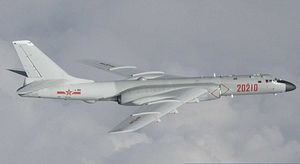For the first time, the Chinese People’s Liberation Army Air Force (PLAAF) and the Russian Air Force jointly conducted a long-range aerial patrol in the Indo-Pacific region on July 23 to “strengthen global strategic stability,” according to the Russian Ministry of Defense (MoD).
Two PLAAF Xian H-6K long-range bombers were joined by two Russian Air Force Tupolev Tu-95MS strategic bombers in a mission over the Sea of Japan and East China Sea. “On July 23, 2019, the Russian Aerospace Forces and the PLA Air Force conducted the first joint air patrol with long-range aircraft in the Asia-Pacific region,” the Russian MoD said in a statement.
The four aircraft “carried out air patrols along a pre-planned route over the waters of the Japan and East China Seas.” The MoD notes that this mission is in accordance with the Russian-Chinese military cooperation plan for 2019. “The event was held within the framework of the implementation of the provisions of the military cooperation plan for 2019 and is not directed against third countries,” the statement reads.
The Japan Air Self Defense Force (JASDF) scrambled fighter jets in response to the joint air patrol to intercept and escort the Chinese and Russian bombers as well as their accompanying support aircraft. According to the Japanese MoD, the two Tu-95MS bombers also flew through the Miyako Strait, situated between the Japanese islands of Okinawa and Miyako in the East China Sea.
The aircraft also reportedly entered South Korea’s air defense identification zone (KADIZ). “The Russian aircraft stayed in KADIZ for about 93 minutes, and the Chinese warplanes stayed there for 85 minutes,” according to Yonhap news agency citing information provided by country’ MoD. Air defense identification zones are not considered sovereign or territorial airspace. South Korea’s MoD said that the Chinese and Russian aircraft were “engaged in coordinated maneuvering” while flying in the KADIZ.
A Russian Air Force Beriev A-50 airborne early warning and control aircraft twice violated South Korean airspace over the Dokdo islets, according to the South Korean MoD. This was confirmed by Japan’s MoD which made the same accusation against the Russian aircraft as it claims sovereignty over the Dokdo, which are called Takeshima in Japan.
South Korea’s Joint Chiefs of Staff (JCS) said the Russian aircraft trespassed into the country’s airspace over Dokdo at 9:09 a.m. local time after entering the KADIZ, where it remained for four minutes. The A-50 returned again at 9:33 a.m and stayed in South Korean airspace for 23 minutes. The Republic of Korea Air Force (ROKAF) scrambled fighter jets in response and fired 20 flares and 360 machine gun rounds as warning shots.
The ROKAF F-15Ks and F-16Ks took action after the A-50 did not answer repeated radio warnings. The incident reportedly constituted the first time that a Russian military aircraft has violated South Korean airspace.
Russia has protested South Korean actions and denied that its aircraft violated South Korean airspace.”The South Korean pilots did not establish communications with the crews of Tu-95MS, fired flares and then the F-16s conducted another maneuver, retreating away from the Russian planes,” Russian MoD said in a statement. The warning shots also drew criticism from Japan, which is locked in a territorial dispute over the Dokdo/Takeshima islets with South Korea.
“Takeshima is Japan’s territory,” Foreign Minister Taro Kono was quoted as saying by The Japan Times. “It is Japan that should take action against the Russian plane that entered its airspace. It is incompatible with Japan’s stance that South Korea takes steps on that,” The islets are located in the Sea of Japan about 200 kilometers from either country’s mainland.
Last month, Japan reported that two Tu-95MS strategic bombers violated the country’s airspace off the Japanese island of Minamidaitō southeast of Okinawa and off Hachijō island in the Philippine Sea on June 20. The JASDF conducted 343 scrambles against Russian military aircraft in fiscal year 2018, which ended this March. 638 JASDF scrambles were against PLAAF and People’s Liberation Army Navy Air Force (PLANAF) aircraft, according to the Japanese MoD.

































